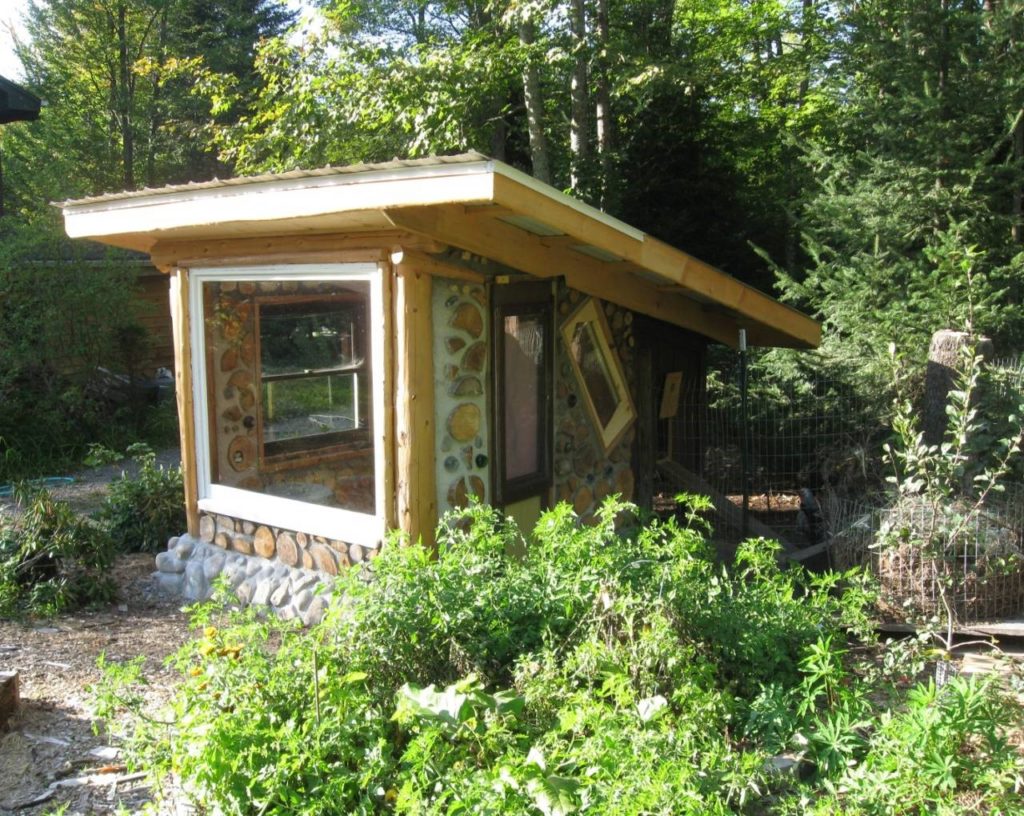By Thomas Huber, Founder & Director
I didn’t know it at the time, but the construction of our cordwood coop began in the spring of 2006 while scrounging cedar log-ends from a local construction company, which specializes in high-end Adirondack great camps for millionaires. The loads of logs I transported in our small Honda Civic (which I thought was going to be for a home addition project) was stored away for four years to be used later as a small-scale backyard permaculture project. A year had gone by since we relocated from Michigan to the Northern Adirondacks, and I was eager to continue building with cordwood, in part to heal a sense of loss from leaving our former homestead behind. However, more pressing projects on the home-front demanded our family’s attention at the time. The older passive solar home we purchased required a considerable make-over, and the retrofit/remodeling projects took a few years to complete.

Designing with Permaculture in Mind
The development of our homestead in Michigan was informed by much of the back-to-the-land literature of the last century. However, I became aware fairly early on in our “home on the land” venture that taking a piecemeal approach with building, gardening, energy needs, etc, often led to avoidable mistakes. For optimal land management and establishing an elegant household-based economy over time, an integrative design process both before and throughout the homesteading experience would not only lead to fewer regrets in building placement decisions, but would greatly enhance every aspect of human settlement by fully utilizing the wisdom of Mother Nature.
Previously, I was introduced to permaculture design developed by Bill Mollison and David Holmgren, and later completed a permaculture design certificate course. Permaculture can be defined as the conscious design of “cultivated” ecosystems that have the diversity, stability, & resiliency of natural ecosystems. It is a harmonious integration of people and landscape in such a way that the land grows in richness, productivity, and aesthetic beauty. Over the past 30 years and drawing on many disciplines and cultures, permaculture has evolved into a comprehensive set of ethics, ecological design principles, strategies, and methods for establishing a more permanent agriculture. It has also grown into a movement dedicated to establishing a sustainable, regenerative culture to creatively address the problems of diminishing resources and the threatened life support systems now facing the world. Permaculture can be practiced on any scale whether it be transitioning a community from its dependence on fossil fuels or assisting a family in meeting a greater share of its household needs from bountiful, backyard means.
Backyard Forest Farming
One aspect of permaculture especially applicable to modern times is the design and development of backyard edible forest gardens to replace the energy wasteful and ecologically barren suburban lawn. Instead of depleting so many resources on the establishment of a grass monoculture, a perennial polyculture food forest is grown instead. Forest gardens are “stacked and packed” agricultural systems which maximize up to seven layers of vertical space (from the root level to the tree canopy) and the selection of multipurpose plants to create high-yielding, low-maintenance food foraging systems. The concept of succession is put to work by selecting perennial fruit and nut trees, which will provide yields over time, while also providing shade, structure, and pollination potential for other plants. Climbing plants, herbs and vegetables, and ground covers are planted to prevent erosion, fix nitrogen, shade weeds, and perform other ecosystem services while yielding food. All the species selected provide multiple functions and help form symbiotic relationships like those found in natural ecosystems, but they are superior in terms of food production which increases over time. The combined yield of the resilient polycultural system is what makes edible forest gardens worth the time, money, and labor required during the early stages of their establishment.
Our two acre parcel in the Adirondacks was typical of most small land holdings of the region. It consisted largely of temperate deciduous forest productive in terms of wood products, but too shady to grow any appreciable amount of foodstuffs. Classified as Zone 3B for agriculture, the Adirondack’s short growing season combined with poor glacial till soils, and prone to regular cold spells due to higher elevation and frost pockets all present challenges for producing home-grown fruits and vegetables. Ironically, we began our backyard edible forest garden by cutting down a small portion of the forest to create a greater solar opening. First though we had to move a small shed that the previous owner placed along the southern edge of the tree line. This shed was to be later incorporated as part of a small hybrid greenhouse/chicken coop repositioned along the northwestern corner of the edible forest garden.
Article continues – Download the entire article here